Leonardo Padura’s Havana Tetrology

Havana Tetrology, or, the Urgent Need to Read Padura
As part of the 29th edition of the Book Fair, Cuban writer Leonardo Padura’s Past Perfect and Winds of Lent were presented. Afterwards, Ediciones Unión will publish a second volume with Máscaras y Paisaje de otoño
Published: Friday 14 February 2020 | 12:36:15 pm.
 By Dailene Dovale de la Cruz digital@juventudrebelde.cu
By Dailene Dovale de la Cruz digital@juventudrebelde.cu
Translated and edited by Walter Lippmann for CubaNews.
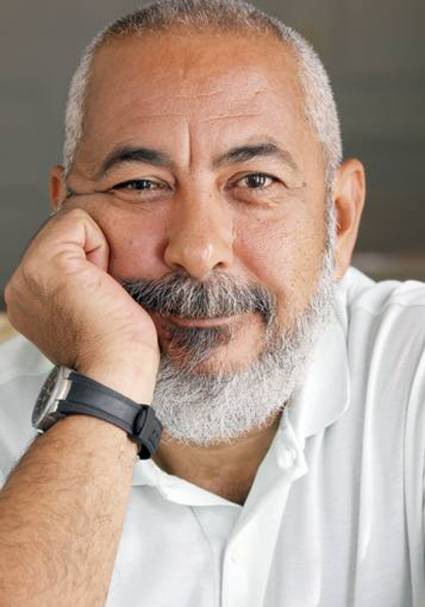
Cuban writer Leonardo Padura. Author: RTVE Published: 21/09/2017 | 06:11 pm
I woke up today with a book in my hands. I read it when I wake up, while I have breakfast, in the bathroom, before getting dressed, when I walk, inside the bus -sweaty and stress- in the Faculty… I lined it with an old magazine to take care of it among so many adventures. He’s my first literary love at this Book Fair.
It was Sunday, February 9, 2020. I had arrived at the entrance of Morro Cabaña. A friend of mine – curly hair, a skinny, ungainly body – greeted me. That day they were presenting Padura’s book, and I suddenly found a direction for my absent-minded steps.
The Alejo Carpentier room received passionate readers, who arrived hours before the meeting, sat down, lined up in a very long queue to buy the book, waited, got excited. Leonardo Padura presented the first two parts of Tetralogía de La Habana: Pasado Perfecto and Vientos de Cuaresma. Later, Ediciones Unión will publish a second volume with Masks and Autumn Landscape.
What is the Count up to, people ask him in the street. Your Mario Conde has transcended printed paper and is no longer yours, or perhaps he never was at all. For Francisco López Sacha this is the Cuban character of the 20th century, just as Cecilia Valdés was in the 19th century.
Leonardo Padura looked confident, proud of his work and of Conde in particular. The afternoon passed peacefully. And the space, small and warm, was full but in total silence. They listened.
Padura spoke of his need to narrate so as not to go crazy in the early 1990s and how his favorite reader is the Cuban public, the one he thinks about while writing in his native Mantilla.

After the immense queue, of passing and paying – “one book per person”-, of receiving with emotion the dedication, the individual is left in front of the work. Why do so many people follow and adore Mario Conde and Padura? That could be the first classic question.
Padura’s novels burst onto the literary scene, to change some fixed judgments especially regarding the crime novel. They are very Cuban novels, in the author’s own words, without imitating some somewhat predictable patterns that characterized part of the detective novel published in the country during the 1970s (with its exceptions).
See here this Timeline (Scroll down for slide show)
http://www.juventudrebelde.cu/cultura/2020-02-14/tetralogia-de-la-habana-o-la-necesidad-imperiosa-de-leer-a-padura
In Past Perfect, for example, the “hero” accumulates defects, vices, incurs a compartment that we could call immoral or that borders on such classification. Nevertheless, it is he who gets up to work – even after a drunken, haggard and exhausted bout. It is he who feels and loves his city, with all its defects… On the obverse side, there are the unpolluted, perfect and false. On them, after the typical characterization (an impeccable man), little dirty rags begin to fall (which in the end are a whole dump).
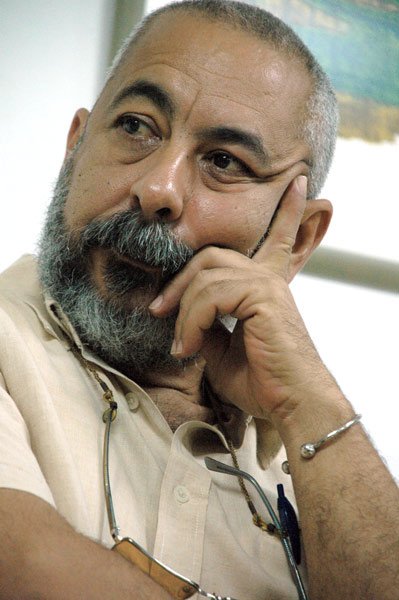
These novels are social criticism, still valid and necessary. The kind of book that catches you on a Sunday afternoon, and accompanies you during your breakfast/lunchtime meals, when you wake up or after you go to sleep. All that remains is to invite you to let yourself be caught. Conde, a little bit disheveled, will teach you the well-known phrase about deceptive appearances and will make you reflect a little bit on Cuba, Havana and how each one assumes and builds life, in the middle of their circumstances.
Cuban Film Critic Praises Recent Lesbian Films
 Elisa and Marcela, Marianne and Héloïse, Jean and Lydia
Elisa and Marcela, Marianne and Héloïse, Jean and Lydia
By Julio Martínez Molina
February 8, 2020
Translated and edited by Walter Lippmann for CubaNews
https://walterlippmann.com/elisa-and-marcela-and-more/

Three very recent films on the international scene, two of them exceptional and one of less artistic importance, are interconnected by both the sensitivity and the tenderness with which they have focused the love between two women. Their stories among the most beautiful provided by this thematic plot in the history of the screen. And to affirm it on a slope that has illuminated masterpieces like Carol and wonders like Disobedience is no small thing.
There are certain gay films with male characters who emulate rabbits in their animalistic urge to fornicate at all times, in any space, with anyone, through the vicissitudes of many bodily fluids and little love. On the other hand, these three stories of lesbian romance stand out in contrast, by celebrating the union of a couple with the understanding of an absolute physical and mental communion, one that dispenses with third parties. Then there’s the finding in the person loved the supreme enjoyment in the physical and spiritual, the acceptance of the other with all its burden of differences, their respect as a human being. This does not imply the overflow of eroticism and passion inherent in every bond that also possesses flesh and desire, manifested in the plots of these three filmic pieces bordered by intense sexual passages.
The first two are the Spanish Elisa and Marcela (Isabel Coixet, 2019) and the French Portrait of a Woman on Fire (Céline Sciamma, 2019); the other is the English The Secret of the Bees (Annabel Jankel, 2018). All of them have been directed by women and perhaps that is where the depth of the formation of the six central characters and their human richness lies; fundamentally the complicity in the approach to their sentimental and moral universes.
Co-written and directed by the Catalan Coixet, Elisa and Marcela, is based on true events that took place in primitive Spain, the first homosexual marriage in the history of that country. It occurred in 1901 by two Galician girls, albeit under the premise of a lie: one of them disguised herself as a man. Although it is still valid today, as they could never undo it, in the absence or flight of their spouses.
Teachers Elisa (Natalia de Molina, in another of the notable compositions of a career in ascent) and Marcela (Greta Fernández, the revelation actress of the moment in the Spanish Peninsula) fight at arm’s length to maintain their relationship in a patriarchal scene of ecclesiastical omnipotence. It is still far from being prepared in the psychological and cultural orders to metabolize such a bond. Misunderstood, rejected and ridiculed, the two young women must leave three countries on two continents in order to continue to be together.
The kernel of the story has to be peeled off in the lyricism by which Coixet approaches a love story. It’s shaped, seen and told from the presupposition of that incomparable beauty arising from loving and honoring being the object of veneration and desire. The intimate scenes of the two central characters are carefully beautiful, and they testify to their mime, to the carnality and spirituality of their passion, to the joint desire to please and love each other; in spite of the hatred and ignorance that hangs over both of them. De Molina and Fernandez, especially the first one, were great.
The visual splendor of black and white photography, great in several shots of interiors, enhances the film.
 Portrait of a Woman on Fire, is sensory as the three previous works of its director, garments the model gradualness through which Sciamma works the romantic attraction of its protagonists. In the first hour of the film, which is calm in its progression and full of details, references and subtleties (those furtive or frontal glances of Héloïse, the lady to be painted, towards Marianne, the painter!
Portrait of a Woman on Fire, is sensory as the three previous works of its director, garments the model gradualness through which Sciamma works the romantic attraction of its protagonists. In the first hour of the film, which is calm in its progression and full of details, references and subtleties (those furtive or frontal glances of Héloïse, the lady to be painted, towards Marianne, the painter!
The two are also in conflict with each other. It was 1770 and the beautiful young bourgeois Héloïse had to be painted, in order to send the canvas to the rich Milanese man who was to marry her. Marianne represents, there is no other, given the time and the conventions, an episode that – although probably the most important thing in her life and never forgotten by her – has to be closed within itself once the lady travels to Italy with her husband.
Noémi Merlant (Marianne) and Adèle Haenel (Héloïse) compose two memorable characterizations. This is decisive in the sense of capturing their characters’ attempt to curb an instantaneous drive and the vehemence with which they accept it and give themselves over to the love affair after realizing how futile the commitment is. The stylization of Portrait of a Woman on Fire is largely due to the observation of the bodies and the close-ups. It’s pure filmic visual poetry that dialogues and transmutes with the pictorial space of the story. Thanks to the mailbox of Claire Mathom, the director of photography.
 Despite being weighed down by dramatic and visually mellifluous decisions in the resolution, as well as appeals to misplaced magical realism and less nuance, The Secret of the Bees is also another tender female story. It is the 1950s in a rural Scotland that does not forgive the “lesbian” Dr. Jean (Anna Paquin, in a work of introversion unaccustomed to the actress in recent times), much less its clandestine union with the young worker Lydia (Holliday Grainger). The relationship between the two, despite their desire for anonymity, will be revealed in the air of a closed atmosphere of intolerance.
Despite being weighed down by dramatic and visually mellifluous decisions in the resolution, as well as appeals to misplaced magical realism and less nuance, The Secret of the Bees is also another tender female story. It is the 1950s in a rural Scotland that does not forgive the “lesbian” Dr. Jean (Anna Paquin, in a work of introversion unaccustomed to the actress in recent times), much less its clandestine union with the young worker Lydia (Holliday Grainger). The relationship between the two, despite their desire for anonymity, will be revealed in the air of a closed atmosphere of intolerance.
In director Jankel’s eyes, this love is marked by tenderness. Although the observation of the two women’s intimate space never reaches the degree of visual sophistication of the films of La Coixet and La Sciamma, such scenes are also very beautiful. Perhaps they are less stylized, but not all of them need to be assumed in such a way.
Never

Never
 Author: Leslie Díaz Monserrat | internet@granma.cu
Author: Leslie Díaz Monserrat | internet@granma.cu
February 9, 2020
Translated and edited by Walter Lippmann for CubaNews.
Sometimes life is heavy. Problems sit on your shoulders, like a burden trying to sink you. In those moments, some hang up their hopes, sit in a corner of their own life and cover their face with their hands.
They don’t know it, but right then and there they have lost, because there is no sadder defeat than the one that comes after you stop fighting.
That’s why I admire the women in my family so much. I admire my mother and her integrity, that ability to stand up after losses, after the deepest pain, after so many things.
That is why I am proud of my country. This is because we have in our blood the lineage of men and women who never saw an option in the word surrender. Men and women who continue to fight, even when everyday life becomes complex.
I admire people who do not lie in bed and watch their problems devour them. I admire people who are scared out of their wits every day when they wake up.
In the end, that’s what life is all about, imposing oneself, drawing paths, not letting time go by without doing at least one good deed.
Life has the taste of the kisses you give, the warmth of the hugs, the color of the people who love you.
Life is built on the footprints you leave on others every time you help them.
Life is not about piling up things, awards, titles. There is an infinite pleasure in seasoning nostalgia with irreplaceable memories.
Life rewards those beings who do not bend to boredom, those who every morning inject themselves with high doses of energy and go out into the street and open the door of their car to those who wait at the bus stop, and give a medicine to those who need it and share a cup of coffee even with a stranger.
With these people, you can build a country, a family. These are the indispensable, necessary beings, those who never give up.
Between You and I, Can There be Another?
Between You and I, Can There be Another?
With the social opening to the free development of sexuality, the existence of new love and relationships between couples is normal and is practiced nowadays
By Leyla M. Mancebo Bada, journalism student
digital@juventudrebelde.cu
Translated and edited by Walter Lippmann for CubaNews.

Open relationships are one of the many examples of love and relationships between couples practiced today Author: Taken from the Internet Published: 13/02/2020 | 07:25 pm
Isabel and Pedro have been dating for almost a year and say they are very much in love. They both showed up at a party, liked each other and then gradually got to know each other better. However, they do not have the traditional relationship of a couple, they “according to the current times and new trends of love”, as they defined it, they have an open relationship.
Yes, open. It is a relationship in which both can meet other people and its members have the freedom to have sexual or affective relationships with third parties, this without including their partner in them and respecting that the greatest source of affection and commitment is maintained in the closed bond of the couple.
They tell us that they are satisfied with their relationship, “there are no complaints, sometimes a little jealousy appears but it soon passes, and the best thing is the freedom to enjoy and live – in a safe and clear way – our spaces, they add. None of this means that there are less moments that we share together as a couple, on the contrary, explains Isabel.
And it is as the Spanish therapist Antonio Bolinches says, in an open relationship, both members agree that they can have other short or lasting relationships. But it is the primary couple that structures their affective life, and where love resides with a capital letter.
“Today there are many open couples,” explains Pedro. We young people experience a lot, and that lack of commitment is more interesting, it gives you more assurance that you won’t be hurt. Who knows, and one day we will no longer want to follow this trend and we will become official in the most traditional way, but in the meantime, we feel good about it”.
[To expand on the topic, listen to the Podcast: Open Couples, Does Love Die?], where JR’s radio show More Than Paper addressed the phenomenon. JR PODCAST: http://www.juventudrebelde.cu/cuba/2017-02-13/jr-podcast-parejas-abiertas-muere-el-amor
Photo: Taken from the Internet
This is just one of the many examples of love and relationships that are practiced today. With the great social opening to the free development of sexuality, it is normal that new definitions and ways of exploring human identity and personality exist.
Likewise, with the arrival of iconic dates such as February 14, known as Valentine’s Day or Valentine’s Day, a whole horde of references to love in its maximum expression is unleashed in society. And I wonder if in the post-modern era we can assume that love is only a matter of two?
Both the officialisation of the LGBTIQ+ community and the emergence of new consensual forms of stable relationships have given way to terms such as polyamory or open relationship. Where monogamous canons are abandoned in order to live love fully, according to the affective needs of each individual.

Polyamory, swingers…
Another very fashionable practice in these times are swinging couples, in which the members of two couples exchange their members for a defined and pre-established time. About this, Mileyda Menéndez Dávila, editor of the Sex Sense section of this newspaper, explains that these are not irresponsible orgies or tasteless youthful discargas (which also proliferate, sadly).
“In addition to the swinging encounters, there are mostly adults with happy marriages, people willing to oxygenate their erotic life without the disparate hypocrisy of infidelity or the renunciation of love cultivated in harmonious coexistence.
“There is a whole code of good conduct in these groups, which includes everything from protection against pregnancy and STIs to the essential reserve in terms of handling private information. One of their passwords is usually inscribed in large letters in the usual meeting places: NO is NO, to make it clear that individual freedom is inviolable in any circumstance” he says.
There are also polyamorous relationships. As the word indicates, it literally refers to many loves and is conditioned by the scientific fact that monogamy is not a question of genetics or inherent in the human condition, but is the product of the historical and social evolution of interpersonal relationships.
In practice, polyamorous relationships are those in which their members have a consensual right to maintain more than one love relationship, and in many cases their members share lifestyles, homes and even assume collectively the raising of children. One of the characteristics of these relationships is the commitment of all parties involved.

Photo: Taken from the Internet
For some, choosing someone exclusively, among so many, to lead an ordinary life is contradictory, because sexual and emotional interest occurs naturally towards more than one person. There are those who say that the main obstacle to enjoying this type of relationship is jealousy, but control of it is a question of acceptance and self-esteem.
All these terms, practices, modernities, or whatever they are called, show us that each individual lives in his own way and has the right to his intellectual and emotional growth, but the openness of the ways of thinking and feeling, helps to achieve empathy with our fellow beings, even when we do not share their practices.
When it comes to love, anything that enriches us without harming others is valid. If loving a person is beautiful and pleasant, and if we also agree to do it in a safe way, then between you and me, there can be one more.
Read also:
And do young people today still fall in love?
21st Century Couples
Love Speaks Through the Ears

Love Speaks Through the Ears
Two decades ago, love was born between Irela and Hugo while they were studying at the Universidad de Oriente. Their relationship became strong despite misunderstandings and prejudices, and today it can be told “on board” of cinemas, books and confessions
 By Liudmila Peña Herrera
By Liudmila Peña Herrera
digital@juventudrebelde.cu
Translated and edited by Walter Lippmann for CubaNews.
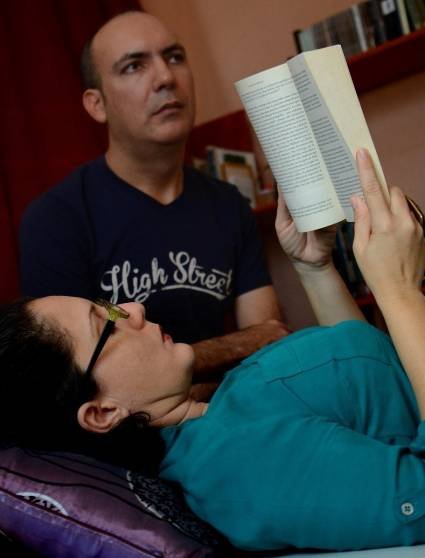
The dark room lights up with every jump of the stage on the big screen. When that happens, even from the back chairs, you can guess the romance. She, with her rebellious curly hair; he, too, with a cascade of hair that spreads across his back.
She whispers something in his ear; he nods without moving his eyes from the big screen. There is a sui generis complicity between these two lovers who whisper so much in their seats. They seem to talk more than they see. They roll the credits, turn on the light and there she is, squeezing her left hand and avoiding him to stumble in the crowd that comes out of the Santiago de Cuba cinema.
Her name is Irela Casañas Hijuelos, she studies Sociology and is not disabled. He is Hugo González Diéguez, future psychologist, and blind due to retinitis pigmentosa as a child. They are holguineros and live the hard 90’s at the Universidad de Oriente. When they can, they escape to the cinema or to a concert at the Sala Dolores.
“At that time Almodóvar’s films were released and she always described them to me.” Hugo speaks as if he were recalling passages from a life he is grateful for. Twenty-two years have passed, his hair is no longer long, but he does not forget Irela’s words in his ear: “They were those other eyes that are needed to enjoy a good work of art”.
What I like about you
When they met, Irela was starting her first year and Hugo was in third. They shared a taste for rock and literature, had common friends and met in the Peña de los Raros.
“The first qualities that attracted me to him were the freshness of his character, his positivity, his spirit,so warlike, but at the same time so ethical, generous, that he faced life with a lot of peace and courage. That’s why I began to admire him and the friendship began to turn into love. Without any kind of prejudice, he did not limit himself to telling me that he loved me. I didn’t limit myself either and let that be born.
He listens to her every word with patience, and assures us that he fell in love with “her sensitivity, her intelligence, her joy, and also her naturalness, her desire for knowledge and life experiences. He could not see her, and yet he saw her.
Love and the physical
It wasn’t love at first sight. Logically. Hugo had never even touched her to know what she looked like, but her voice and her personality bewitched him.
“Saint-Exupéry said that the essential is invisible to the eyes; that one can only see well with the heart. For me, above all, love is sympathy, a connection between two souls who find points in common. I liked her voice very much because it was pleasant and feminine, without resorting to subterfuge to please. And it is scientifically proven that smell is very important in attraction. That, and our affinities, were fundamental”.
Fears
Irela says no, that she was never afraid, that “it is society, with its hostile views and labels, that tells you, ‘Look, there is fear. You have to know it.” But I wasn’t afraid to let the relationship flow. It was something so natural, so beautiful, that we didn’t question anything and started to grow together, to enjoy each other.
Hugo, on the other hand, was afraid. But his was not the fear of others, of the questioning of others. He was afraid of the possibility of rejection. “When you care for someone very much, as I did for her, that’s what happens. It was very important that she accepted me and felt for me what I was feeling for her.
The acceptance
Irela was always a determined young woman, free as her curls, and judicious, confident. She cared about the acceptance of her own – who wouldn’t? – but that was not what would define the future of her relationship with Hugo.
“There was a little fear in my family, but when they realized that our relationship was very serious, that I was not going to give up, they began to accept my decision. Besides, with Hugo’s character, his authenticity and his noble and positive spirit, it is impossible not to admire him.
And they admired him. Or better yet, they admire him. Hugo is as grateful as he acknowledges his parents for never having been an obstacle: “I was always independent. They saw that step of mine as another sign of my way of being, and they supported me”.
Growing up together
At home, Irela reads you the subtitled films, and describes the visual works when they go to an exhibition. They almost always hang out together, except when she goes to La Mezquita publishing house, where she works, and he enters her office as a clinical psychologist at the Pediatric Hospital.
But what unites them most – besides love – are words. They both write. Their passion for literature is another bond, another link, and it has helped them to drive each other forward.
“I dedicated my first book to Hugo; although I read since I was a child, he helped me rediscover literature and start writing”.
Irela has published two books of poetry and one of essays. Some time ago she was a literary editor at Ediciones La Luz, and her professional experience has been vital to him as well: “Because of her work, she is an implacable critic of my texts when she has to be”.
Hugo published a book of poetry and has another one in the process of being edited. He says that Irela does not praise without reason. He knows her and she inspires him: “She is my fiercest critic and, at the same time, my best muse”.
Prejudice
“Many people have asked me, ‘Are you two brothers? They do not understand how it is possible that, with my disability, I have such a beautiful and intelligent woman. They also ask me if she is blind or visually impaired; but there is no doubt that, in the eyes of society, she is more exposed because she is a woman and because she does not have the disability.
Hugo’s reflection is sharp. For Irela, it certainly seems to have been more difficult: “I have suffered harassment from unknown men who have seen me with him and said unpleasant things to me. But what struck me most, at the beginning of my return to Holguín, was that some people, supposedly very liberal because of their cultural work, said indirect phrases to me that denoted prejudice; although it is important to clarify that we have always received many more signs of friendship than of prejudice”.
Everyday life, jealousy, trust
“We try to make everyday life not just mean staying alive, but that life is beautiful, diverse. Thanks to the support of his family, we have our own house, in which we share the housework. He, for example, likes coffee because it gives him the exact amount of sugar that we both like. I sometimes go a little overboard,” Irela accepts and laughs happily.
Hugo laughs too. And both confess that they try to read, enjoy an audio-commented film, and be surrounded by friends… but together, always together, without untimely jealousy, because “they show little confidence in themselves. We are not jealous and that security protects us. For me it’s not a problem that she can watch and that I don’t notice. I know what I am worth and how important I am to her.
Irela and Hugo
They walk the Holguin streets talking, laughing, waving… They go hand in hand looking for the shadow, if there is one. They transmit serenity, and also something unusual, difficult to translate with words, which perhaps has to do with their way of understanding life.
“We enrich the routine: I practice yoga and he does the Tibetan rites. Besides literature, he loves football: he’s a Real Madrid fan,” she says, and Hugo adds other ingredients to a love recipe they have been perfecting for more than two decades:
“Irela and I have built a couple without secrets. There is trust, respect and complicity. She’s not just my wife: she’s my partner, my accomplice. We love each other, but we are also friends.
And the confession brings them back to that Santiago cinema of his youth, where she narrated the film to him in a low voice while he felt that love spoke to his ear.
In the Name of Love

In the Name of Love
Granma joins the celebration for the Day of Love and Friendship, in which many men and women of this land defend the love of their hearts and that of their country
Author: Madeleine Sautié : madeleine@granma.cu
13 February 2020 23:02:05
Translated and edited by Walter Lippmann for CubaNews.

Photo: Dunia Álvarez Palacios
How do you write about love without the spirit of the poet being stamped on the white page? How do you touch it and say: “Hey, look, I’m writing, and you’ve crossed my mind, so you don’t leave me, so you’ve said everything.
“As if one could choose in love, as if it were not a lightning bolt that breaks your bones and leaves you staked out in the middle of the courtyard,” says the Cronopio major, preventing the advancement of the very letters that now seek to move aside that great of the Golden Age, which defined the greatest of feelings as “a carelessness that gives us care, / a coward with a brave name, / a lonely walk among people, / a love only to be loved.
The bard of swallows arrives at the round that is already forming: “The words of love will come back in your ears, / the burning words will sound, (…) as I have loved you…, disengage yourself, like this… they will not love you,” and the one who wrote the lyrical hexahedron sings: “Your love burst into my life like a gust through an open window.
“To suddenly know / that I was going to see her again, that I would have her / close, tangible, real, as in dreams. / What a contained explosion! / What a deaf thunder / rolling in my veins,” says the National Poet, just after the greatest of Cubans, in perfect rhyme, said: “I thought of you, and of your hair / that the world of the shadow would envy, / and I put a point of my life in them / and I wanted to dream that you were mine.
***
It is not always a peaceful stage where love verses nestle. Beyond their natural agitation, in very raw circumstances poems have been conceived, which as hymns deserve eternal deference.
Far from home and from his beloved, the Shepherd of Orihuela wrote, fighting Spanish fascism, his Song of the Soldier Husband:
“When I think of you on the battlefield, / my forehead that does not cool or appease your figure, / you approach me like a huge mouth / of hungry teeth. / Write me to the fight, feel me in the trench: / here with the rifle I evoke and fix your name, / and I defend your poor womb that awaits me, / and I defend your son.”
Like him, like the Salvadoran guerrilla who asked his beloved not to say her name when she knew of his death, many men and women today defend their love, that of their heart and that of their country, which is the greatest affection, in the most hostile environments. A world plagued by imbalance, subjugated by unreason, attempts against the happy destiny of men. May this day when love speak louder leave us for a few moments, not only to invoke peace, but to do what we must, in the name of love, for it.
Bolivia: Witch Hunt Against MAS…

Bolivia: Witch Hung Against MAS…
In addition to the disqualifications proclaimed by the Supreme Electoral Tribunal of Bolivia, there is a campaign in crescendo against the candidatures of the Movement to Socialism
Posted: Wednesday 12 February 2020 | 10:37:56 pm
 By Marina Menéndez Quintero
By Marina Menéndez Quintero
marina@juventudrebelde.cu
Translated and edited by Walter Lippmann for CubaNews.

Thousands of MAS followers proclaimed Arce and Choquehuanca in Sacaba, Cochabamba. Autor: Twitter Published: 12/02/2020 | 10:15 pm
The disqualification, on Tuesday, of 365 candidates for the seats in Congress – which will also be held in Bolivia on May 3rd – shows just the tip of a campaign against MAS that has already been launched from the violent, from the “legal”, and now muddies, as expected, the electoral panorama.
The lack of transparency and credibility will affect many. It is true that most of the candidates eliminated from the race did not belong to the Movement Towards Socialism (MAS). Most (205) are from the right-wing Front for Victory, which in October nominated Chi Hyung Chu – a Bolivian of Korean origin who, although distant from Evo Morales and coup leader Carlos Mesa, came as a surprise when he came in third place… (Let’s not forget that usurper Jeanine Añez is now also running, and has aspirations).
But the MAS has 57 people who have been disqualified. And although the impossibility of going on the ballot also extended to members of the very group that represents Añez (the Juntos alliance, with only nine ruled out). So it is obvious that the fundamental blow is against Evo’s party, which was first in the polls since the beginning of the polls and when Luis Arce had not yet been chosen as its candidate for president.
This is the political grouping that has had the greatest impact in deep Bolivia after 14 years of refoundation, and in spite of the misunderstandings of certain neglected sectors that today are allied with the oligarchy, or are victims of its manipulations the crowds that came to receive Arce and his running mate, David Choquehuanca, when they returned to Bolivia a few days ago, showed that support.
The vulgar “cut” of MAS candidates for senator and congress is being justified by the supposed absence of certain documents and other bureaucratic requirements. It’s an argument as little credible as it is scarce the confidence in a Supreme Electoral Tribunal replaced without reason by the coup plotters, and headed by a headline that was slected “by hand”.
First, they persecuted and imprisoned the best leaders of the Movement Toward Socialism; then they confronted them with false accusations, and now they are preventing them from running.
It is hard to believe that officials as lowly as those who seized power would allow a return of the MAS to the House of the People or the Palace of Quemado. In order to wipe out their management, they are dismantling the fruits of the model.
The “hunt” goes on for more. Luis Arce has been linked to an alleged embezzlement in the Indigenous Fund. It could be used to get him out of the game at the right time. All that would be needed is to make the charges official (everything about it is false!) and call him to trial, or lock him up?
Meanwhile, the campaign against Evo is spreading. Not only has he been charged with terrorism and sedition, charges sent to Interpol to circulate an arrest warrant, which that agency rejected.
The alleged request by social and popular organizations to prevent Evo from running for the Senate has become a recurring theme in the official media. The argument is that he does not meet the requirements either because “he lacks papers”. This is the same sword wielded against Arce so that he does not seek the presidency either, and against Diego Pary, the former foreign minister, so that he is not allowed to run for the upper house.
This Wednesday, the former candidate and coup leader Carlos Mesa – Evo’s contender in October and the one who proclaimed the false fraud that opened the door to the coup -, asked the Prosecutor’s Office to extend the investigation against Evo, and to include the former vice president, Alvaro Garcia Linera, and the former ministers Juan Ramon Quintana (a refugee at the Mexican Embassy), Carlos Romero and Hector Arce.
His ploy is to link them to alleged “electoral frauds” in light of the frustrated October elections.
There is everything in the vineyards of this Bolivia of falsified institutions. There may be even more if, as some fear, the worst machinations are yet to come.
Is Cuba Today Violent and Insecure?

Who Wants the World to Believe that a Climate of Insecurity and Violence Exists in Cuba?
The blockade causes shortages, consumption is affected, constant feelings of anxiety are created, counter-revolutionary media try to connect people to hate. We have been educated according to principles of humanism and justice. Hate does not build. Let us not be manipulated
Author: Raúl Antonio Capote | internacionales@granma.cu
February 12, 2020 23:02:52

The National Revolutionary Police have been involved on many occasions in returning items stolen from schools to students. Photo: Juvenal Balán
On Tuesday [February] 11, at 12:26 p.m., a message surfaced on the internet, arousing the interest of thousands of people. One Internet user wrote on Facebook: “I just saw something shocking”, and was moved to tell of the courageous and dignified performance of a National Revolutionary Police (PNR) officer. “Alone, against an enraged mob determined to lynch a rapist, she, with no other shield than her body, fulfilled her duty (…) to protect his life, so that justice would apply the law to him”.
At the time, hundreds of people shared and commented favorably on the message, and the video uploaded to his channel by the Guerrero Cubano (Cuban Warrior) YouTuber, which motivated the Internet user’s writing.
In the material of Guerrero Cubano, one could appreciate the determined and just action of our police on February 8, in Santiago de Cuba. Proceeding according to the law, she was carrying out the arrest of a person who was accused of having committed a monstrous crime: the rape of a girl under eight years old. Meanwhile, a group attacked the law enforcement officers who, in spite of the complex situation, never lost their cool and acted with great professionalism.
In the course of these events, calls to lynch, burn, destroy, and confront the police began to appear in the networks. Unscrupulous people, taking advantage of the pain of the victim’s relatives, friends and neighbors, called for chaos and accused the PNR and the government of “protecting” the rapist.
The crime, unusual in our Island, awoke the indignation and anger of the people, in a country where respect for children is an essence and not a slogan.
The calls to violence and disorder using digital networks, messages that appear with a certain degree of synchronization, of articulation, in the main media of the counterrevolution, cannot be a coincidence. They appear in the same media that supported the wrongly called “Clandestinos” who tried to stain the immaculate image of the Apostle of Cuba, José Martí. These were the same “false democrats”, the same mercenaries, seeking, through the manipulation of the sensibility of a case like this, to involve people in acts against themselves.
The mechanisms of chaos and violence
The economic war against the island is increasing, using the method of blaming the victim. As the precept of unconventional warfare says, one must try to “achieve the strange result that the victim not only does not complain, but ends up blaming himself for his misfortune and applauding the executioner.
The blockade causes shortages, consumption is affected, constant feelings of anxiety are created, counter-revolutionary media try to connect people to hate, to lie to them, to mobilize them, and to skillfully pull the strings of rancor to turn people into a time bomb.
They “prepare the ground” with the aim of provoking great mental confusion, in the face of the avalanche of facts, messages, and false news. “Citizens fall into such a state of regression that they cannot think rationally, nor protect their interests,” the CIA manuals say. In that state, many people are easily manipulated.
Not for nothing did the subversion plans in the Obama era not renounce economic warfare. On the contrary, the Genesis project, to cite one example, clearly explained that it was necessary to “rigorously maintain pressure on the economy, to force the government to negotiate from disadvantaged positions”. It was a mixture of cultural seduction and economic suffocation.
During the presentation of the draft resolution Necessity of ending the economic, commercial and financial blockade imposed by the United States of America against Cuba, in New York on 7 November 2019, Cuban Foreign Minister Bruno Rodríguez Parrilla, stated: “In recent months, the government of President Donald Trump has begun an escalation of its aggression against Cuba, with the application of unconventional measures to prevent the supply of fuel to our country Its aim, in addition to affecting the economy, is to damage the standard of living of Cuban families. The United States government is indeed responsible.
About 187 actions, including fines, sanctions and measures against the Cuban people, were taken in 2019 with the aim of generating hardship, dissatisfaction and an uprising against the government. This was rightly stated in Lester Mallory’s Memorandum in 1960, which proposed to provoke disillusionment and discouragement in the population in order to facilitate the overthrow of the Revolution.
They want to leave us without fuel for transportation without gas to cook our food, to paralyze the country, and to affect the daily life of the Cuban family in order to wrest political concessions from us. They need a lot of hatred, they need fear, they need to annul the judgment of the people, so that they act irrationally, to annul their psychological defenses, to destroy their self-esteem.
Cuba has been the object of a systematic campaign of motivational influence, pure and hard psychological warfare, fabricated in the laboratories of the CIA. Its goal has been to build a state of mind that will lead the people to act beyond all logic, one that will move them to execute aggressive actions, and to create a state of irrationality that can turn the human being into a beast. In that state, scientifically managed, they try to lead them to the achievement of the action desired by the manipulator.
As the ideologists of the Guarimbas, the Ukrainian Maidan, of George Soros and Gene Sharp, the “internationalist” Otpor boys, repeat over and over again: their aim is to make sure that nothing remains but chaos.
The narrative of indignation in the service of imperial plans
In Bolivia, gangs of criminals, under the guise of “popular indignation” over alleged electoral fraud, took control of cities, carried out roadblocks in the style of Venezuelan guarimberos, burned institutions, made threats, committed murders, tortured people on the streets, and humiliated social and political leaders.
The modus operandi is not exclusive to our region. In November 2019, Iran suffered a wave of violence that destroyed 730 banks, 70 gas stations, 140 government buildings and more than 50 security force bases.
Behind this perfectly-crafted scenario was the targeting of protests, the escalation of violence, and the use of criminal recruitment to attack the security forces.
In 2004, Otpor leaders Srdja Popovic and Slobodan Dinovic created the Center for Applied Nonviolent Strategy and Action (Canvas) in Serbia, an attractive and productive business financed by the US government.
The manual Nonviolent Struggle: 50 Crucial Points, became the “Bible” of the seditious and terrorist movements in Arab countries and Latin America, as much or more than the manuals of Gene Sharp, Bob Helvey and Ackerman, pioneers in the name of this strategy, and its precepts have been applied against Venezuela, Iran, Ukraine, Syria, Bolivia, etc.
Genesis, a project of ideological political subversion developed for Cuba, perfectly described this type of scenario: “Once the intentions of the movement are publicly declared, the highly committed activists are recruited, they move on to carry out street actions that generate repressive action by the security forces, in such a way as to create a state of ungovernability and chaos that justifies, always at the request of the Cuban people, United States intervention”.
What is raised on hate does not hold
Who is interested in making the world believe that a climate of insecurity and violence exists in Cuba? The Miami hate machine, the mud producer, which is profoundly anti-Martian, which is the same as saying anti-Cuban; which ignores an essential principle of the Apostle, everything that tries to rise above hate does not stand. Martí was a revolutionary without hatred, which is why he disagreed with “the barbarians who entrust everything to force and violence”.
The PNR acted in accordance with the law, in a country of laws that respect above all things the integrity of the detainee, a detainee who is not guilty until he is tried and sentenced. The PNR acted in accordance with the tradition learned from the founders of the nation, in accordance with a Revolution that tried war criminals, murderers who committed atrocious crimes, tortured and disappeared thousands of young Cubans. Batista’s torturers were not lynched, they were put on trial with all the guarantees of due process. That is how we acted then and that is how we will always act.
The person guilty of such an atrocious act will be tried and convicted, we have no doubt. We have been educated according to principles of humanism and justice that are the essence of the “sun of the moral world” to which we aspire. Hate does not build. Let us not allow ourselves to be manipulated.
Rape and stones in Santiago de Cuba. The whole truth. Cuba
Cuban Warrior T-3
1.68K subscribers
The networks have begun to manipulate an event that occurred in Santiago de Cuba, during the arrest of a subject with HIV who raped a girl under 8 years old. Hundreds of outraged people tried to attack him and the police fulfilled their duty to protect him. Some vandals took advantage of the situation to throw stones. #Cuba #Miami
TRANSLATION by Walter Lippmann for CubaNews.
Sanders Wins New Hampshire Primary

Bernie Sanders Wins New Hampshire Democratic Primary
Sanders showed his support among Democrats and took more than 25 percent of the vote
Author: Web Editor | internet@granma.cu
February 12, 2020 12:02:31
Translated and edited by Walter Lippmann for CubaNews.

Photo: Radio Havana Cuba
The Democratic primary left Bernie Sanders in New Hampshire as the winner today and turned around the result of the February 3 Iowa caucus, which gave an advantage to former South Bend, Indiana Mayor Pete Buttigieg.
Gone is the chaotic assembly of nine days ago, whose late delivery of results due to a computer error led to all sorts of criticism and suspicion of the Democratic Party.
In the New Hampshire election, Sanders confirmed his status as favorite among the Democrats and took more than 25 percent of the vote, while Buttigieg came in second place.
On his Twitter account, Sanders announced, “Our victory in New Hampshire is not about me. It’s about us. It’s about the movement our grassroots supporters, volunteers and donors built that will transform this country.”
Minnesota Senator Amy Klobuchar surprised the crowd and placed third in the vote count.
Only these three candidates earned delegates in this nomination contest to find President Donald Trump’s rival in November.
For a pre-candidate to get delegates, they had to win at least 15 percent of the vote,. This was a condition that was not met by, for example, Senator Elizabeth Warren, who did not get even 10 percent.
While the progressive Sanders led the Democratic presidential primary Tuesday, now former favorite Joe Biden suffered another major setback that now raises doubts about the viability of his campaign.
In the second nomination contest to find Donald Trump’s opponent, the former vice president was fifth, far behind the first choices and behind contenders such as Warren and Klobuchar. In Iowa, Biden had been fourth.
As if anticipating the disappointing result, Biden left New Hampshire and headed to South Carolina long before the results began to be known.
Biden, 77, did poorly in two previous presidential nominations before winning the 2008 election as President Barack Obama’s number two.
Now he hopes to stay afloat at least until the Feb. 29 elections in South Carolina and a series of contests in other southern states on so-called “Super Tuesday” of March 3.
Businessman Andrew Yang and Senator Michael Bennett dropped out of the race for the Democratic nomination, due to poor results in the Iowa caucus and New Hampshire primary.
Their withdrawal leaves nine Democratic candidates in the presidential race: Bernie Sanders, Pete Buttigieg, Amy Klobuchar, Elizabeth Warren, Joe Biden, Mike Bloomberg, Tulsi Gabbard, Tom Steyer and Deval Patrick.
(Prensa Latina)
Cristina Spoke About “Sincerely”

Cristina Spoke About “Sincerely” at the Havana Book Fair
Díaz-Canel joined the Argentine Vice President during the presentation of her book in Havana
By Marina Menéndez Quintero
February 8, 2020
Translated and edited by Walter Lippmann for CubaNews.
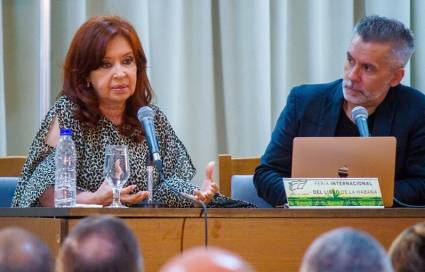
The presentation of Sincerely in Havana is the first that Cristina Fernandez has made outside of her country, and also the first in her capacity as Vice President Author: Maykel Espinosa Rodriguez Published: 08/02/2020 | 09:17 pm
A “crowd” of Argentines had been chanting for a few minutes: “Ya volvió, ya volvió” (He’s back, he’s back), among other songs, when one of Cristina Fernández’s compatriots suggested: “Uno cubano, uno cubano” (One Cuban, one Cuban). Then we heard: “Pa’ lo que sea, Cristina; pa’ lo que sea!” (Whatver you want, Cristina. Whatever you want!”)
Shortly thereafter, the former president and current vice president of Argentina burst into the crowded Nicolás Guillén hall of the Morro-Cabaña Complex, accompanied by the Cuban president, Miguel Díaz-Canel Bermúdez.
The preamble to a meeting that went beyond the mere formal presentation of a book could not be different, because Sincerely – her first volume of this type, and the one that precedes it with three others that compile speeches and texts – is much more than a strictly literary event and also constitutes, as the presenter Marcelo Figueras, an Argentine journalist, commented, a “political phenomenon”.
The text -a bestseller since its presentation in Argentina last April, welcomed with anticipatory warmth, the electoral results that would follow- was started by Cristina on the eve of the electoral transfer to Mauricio Macri, as she wanted to tell what had happened to her and to Argentina after that day.
She finished it in Cuba, where she finished writing the last chapter, started in the dining room of her house before coming to visit her daughter Florencia -sick from stress and cared for here, in March 2019-, which turned out to be, in the end, the first chapter of a book that, she clarified, is not an autobiography.
Combative as the passages that the author narrates and the greetings that she received were Cristina’s comments – although casual and often humorous – during the evening, led by colleague Marcelo with that professionalism shown when he asked the Vice President almost everything that each of the attendees would have liked to know.
In the case of the years of “Macri-ism”, they could not be left out of the book or the notes with which she explained its content, phenomena such as lawfare or the judicialization of politics, which she described as a special chapter of Latin America, but which acquired in Argentina a mafia and anti-family component, with the purpose of stigmatizing it.
It was no longer necessary to “disappear”, as the military did during the dictatorship against “dissident militants” of Latin American governments. This was replaced by media suppression through stigmatization, he explained.
In Argentina, after that dictatorship that began in 1976, a financial model came into place that indebted the country by more than ten billion dollars a year and tied it to the International Monetary Fund (IMF) until the arrival of Néstor Kirchner to the presidency, the development of an industrialization model and the payment that de-indebted the nation. For the first time Argentina, he noted, was not subject to IMF conditionality.
But with Macri came another period of indebtedness amounting to $30 billion per year, which left Argentina receiving the new administration with a debt of $44 billion to the IMF. “That was not by chance”, he said.
Cristina beieves that this should be a turning point and that the sovereign debt should be investigated, as a way to prevent the cycle from repeating itself, independently of the debt restructuring process initiated by the government of which it is part. “A point must be made. Never again,” he said.
She reaffirmed the position of the Frente de Todos and Alberto Fernández since the electoral campaign. You can’t pay if the country can’t grow economically, and you can’t grow if you don’t inject investment into the economy. The first thing we have to do to pay is to get out of the recession, he said.
Cristina Fernández gave a masterly lecture. And she gave it as she wrote: Sincerely.
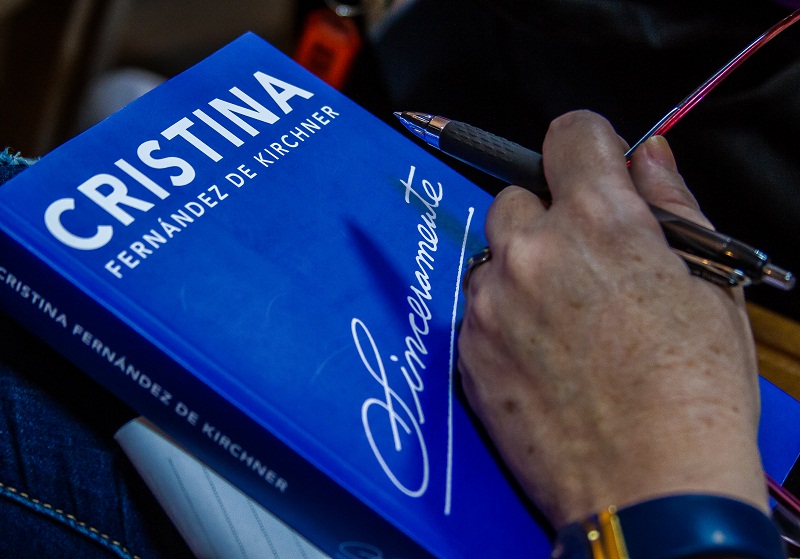

Cristina thanked the medical attention received in Cuba by her daughter Florencia, and had words of recognition for the health professionals of the Island. Photo: Maykel Espinosa Rodríguez
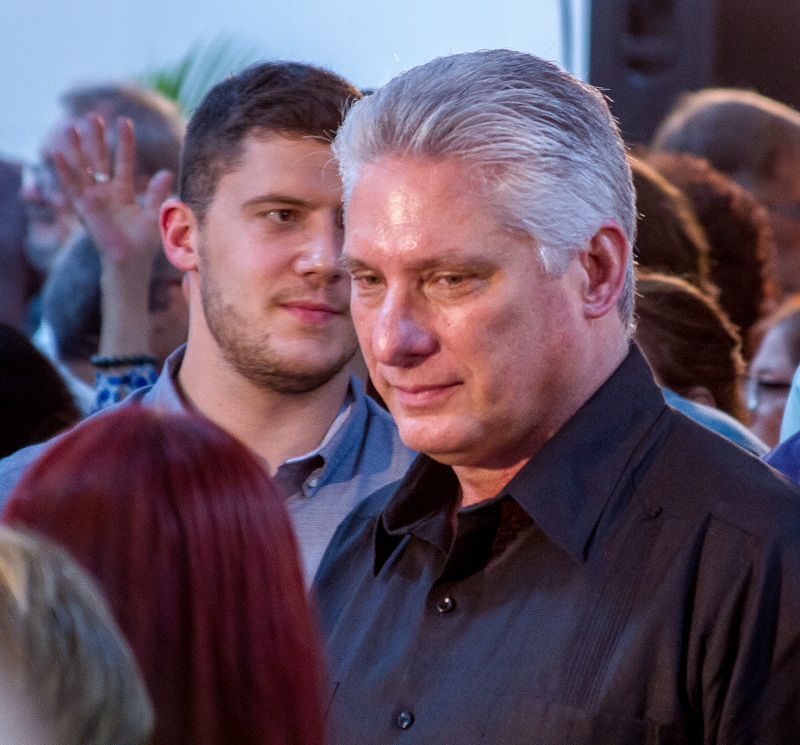
The President of Cuba, Miguel Díaz-Canel, attended the interesting evening together with intellectuals and the general public of the Island, as well as Argentinean visitors to the Fair. Photo: Maykel Espinosa Rodríguez
FULL VIDEO
Subscribe to Blog via Email
| M | T | W | T | F | S | S |
|---|---|---|---|---|---|---|
| 1 | 2 | 3 | ||||
| 4 | 5 | 6 | 7 | 8 | 9 | 10 |
| 11 | 12 | 13 | 14 | 15 | 16 | 17 |
| 18 | 19 | 20 | 21 | 22 | 23 | 24 |
| 25 | 26 | 27 | 28 | 29 | 30 | 31 |

You must be logged in to post a comment.